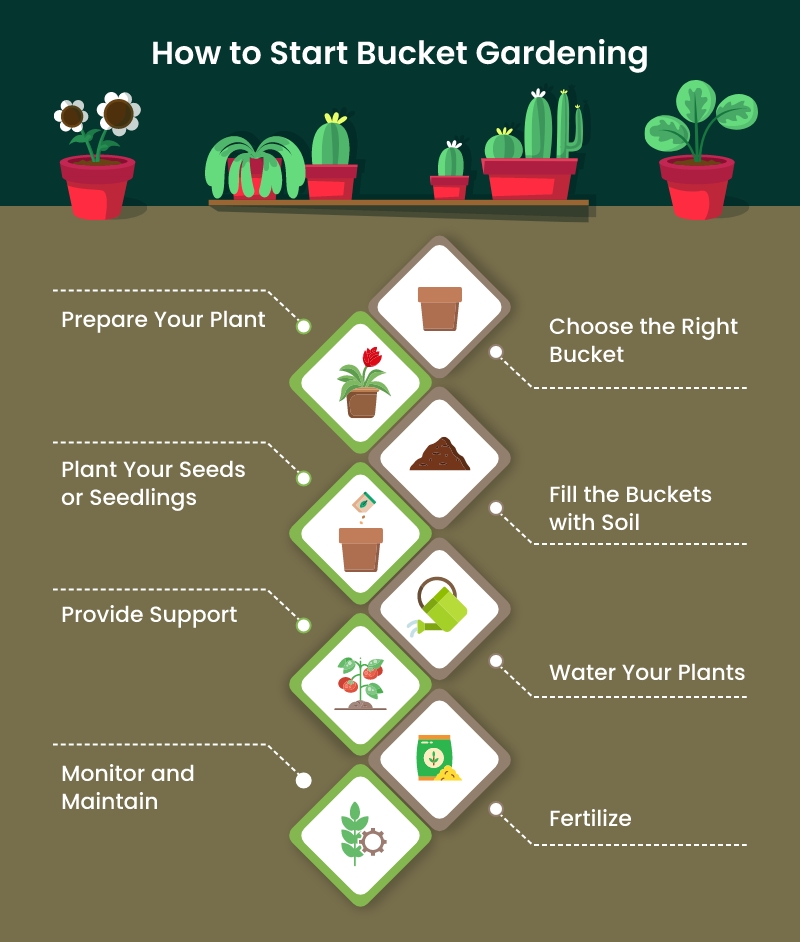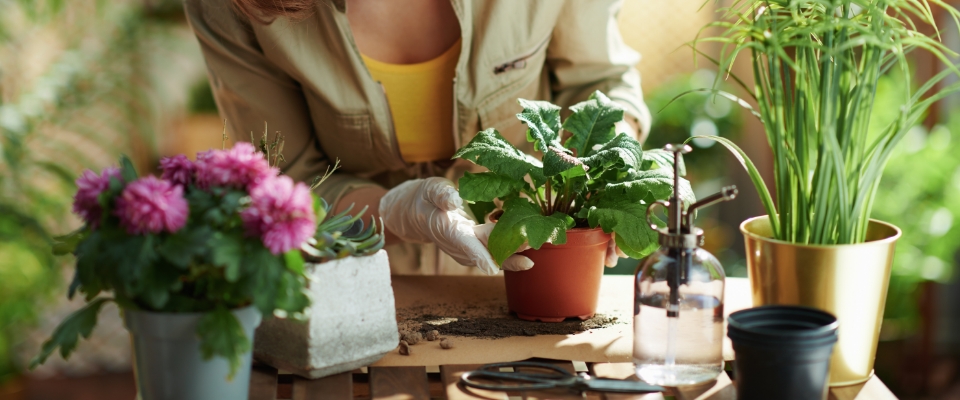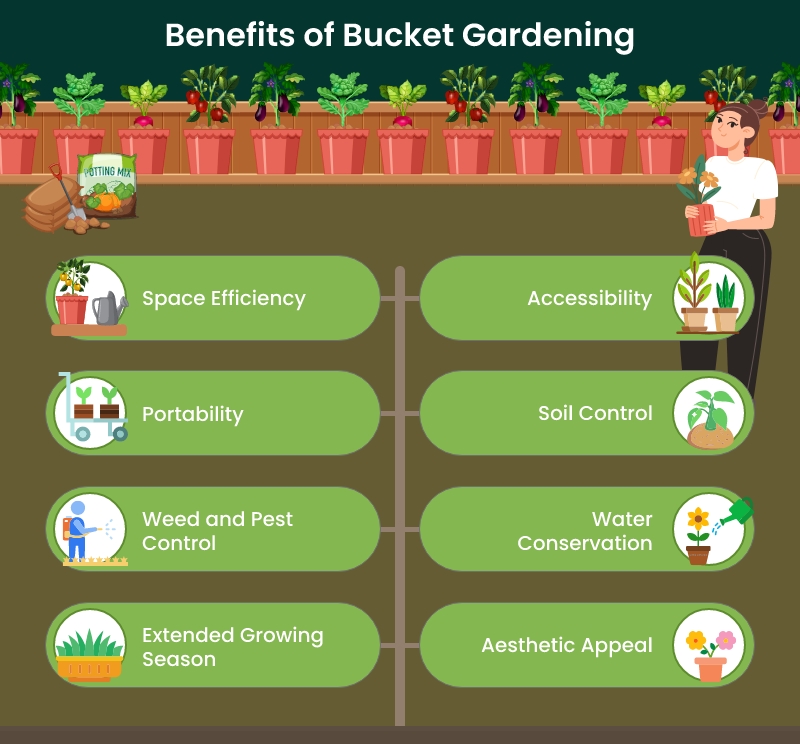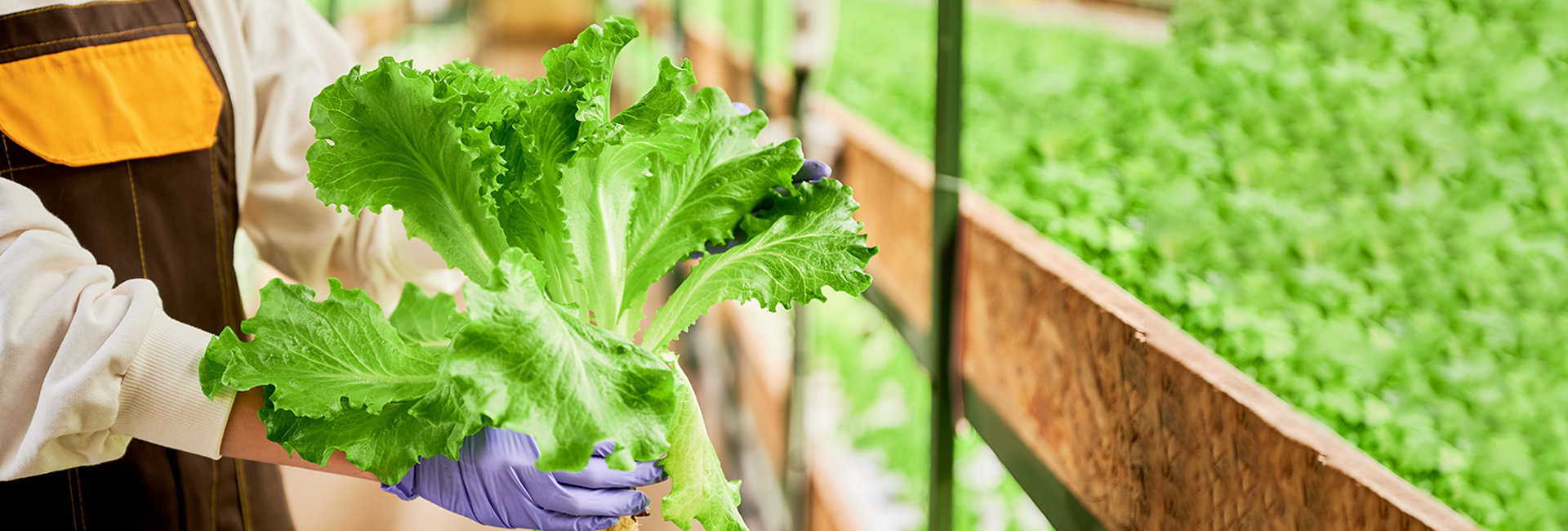Gardening has become increasingly popular as people look for sustainable ways to grow their own food and add unique beauty to their living spaces. One gardening trend that stands out due to its simplicity and efficiency is bucket gardening.
Want to give bucket gardening a shot? Get started with our guide, which covers everything you need to know about creating a garden in a bucket.
Keep reading to learn how to select the right buckets and prepare your plants, to the many benefits of this gardening method.
What Is Bucket Gardening?
Bucket gardening is a type of container gardening where plants are grown in buckets or similar containers. This method allows for growing various plants in small spaces like balconies, patios, or even indoors. Using buckets helps gardeners control soil quality, manage water efficiently, and move plants to get the best sunlight.
How to Start Bucket Gardening

Ready to get your hands dirty? Here’s a step-by-step guide to help you start your own bucket garden:
1. Choose the Right Bucket
Selecting the right bucket is key to your garden’s success. Choose buckets that are at least 3 gallons to give roots enough room to grow. Match the bucket size to the type of plants you have; larger plants need bigger containers.
Use food-grade plastic buckets to avoid harmful chemicals. Drill several holes in the bottom for drainage to prevent waterlogging and root rot. Elevating the bucket a bit can also help with air circulation and drainage.
2. Prepare Your Plant
Start by choosing healthy seeds or seedlings from a reputable supplier. Pick plants suitable for container gardening and your local climate, like tomatoes, peppers, or herbs. Research their specific needs, such as sunlight, water, and soil preferences, to provide the best growing conditions.
Make sure your containers have good drainage to avoid root rot, and use a high-quality potting mix for better nutrients. Regularly check your plants for pests or diseases to catch problems early and keep your garden healthy.
3. Fill the Buckets with Soil
Fill your buckets with loose, high-quality potting soil. Avoid garden soil, as it’s too dense and doesn’t drain well, which can cause root rot and poor plant growth.
Mix in some compost to enrich the soil with extra nutrients for healthy plant development. Fill the bucket about two-thirds full to leave space for watering and root growth.
4. Plant Your Seeds or Seedlings
Make small holes in the soil according to the depth guidelines on your seed packets or plant labels.
Use a small trowel or your finger to get the right depth. Carefully place your seeds or seedlings in the holes, ensuring they’re positioned correctly. Cover them with soil and press down gently. Space them properly to avoid overcrowding and competition for nutrients and water.
Ensure there’s enough room for growth and air circulation, which are essential for healthy plants. After planting in a bucket, water the soil lightly to help the seeds or seedlings settle.
5. Water Your Plants
Water your new seeds or seedlings thoroughly to help them start strong, ensuring the water reaches the root zone.
Follow a regular watering schedule, keeping the soil moist but not soaked, to prevent root rot. A good rule is to water when the top inch of soil feels dry.
Consider the specific needs of your plants, as some may require more frequent watering due to their unique needs or environmental conditions.
6. Provide Support
If you’re growing tomatoes or peppers, provide support as they grow. These plants can get heavy with fruit and may topple without proper support. Use stakes, cages, or trellises to keep them upright and ensure they receive enough light and air.
Supporting your plants also helps prevent diseases by improving air circulation around the foliage and makes harvesting easier. Regularly check and adjust your supports to accommodate the growing plants.
7. Fertilize
Feed your plants with a balanced, water-soluble fertilizer every few weeks to ensure they receive essential nutrients. This will support healthy growth and development, promoting vibrant foliage and stronger root systems.
Be sure to follow the instructions on the fertilizer package carefully to avoid overfeeding, which can damage the plants. Additionally, consider the specific needs of each plant type, as some may require more frequent or specialized feeding to thrive optimally.
8. Monitor and Maintain
Regularly check your plants for pests or diseases, like holes in leaves, discolored spots, or odd growth patterns. Quickly remove any dead or yellowing leaves to prevent disease and keep your plants healthy.
Prune as needed to promote healthy growth and flowering, cutting back overgrown branches and removing spent blooms to encourage new growth. Also, consider rotating your plants for even sunlight exposure and use organic fertilizers to boost their nutrients.
What Are the Types of Buckets for Gardening?
Choosing the right type of bucket can make a world of difference in your gardening experience. Here are some options to consider:
Standard Plastic Bucket
A standard plastic bucket is a popular choice for bucket gardening. These buckets are durable, affordable, and readily available. They typically come in sizes ranging from 1 to 10 gallons, making them suitable for various plants.
Recycled Containers
Using recycled containers is an eco-friendly option for bucket gardening. Items like old laundry baskets, large yogurt tubs, or even paint buckets can be repurposed into plant containers. Just ensure they are cleaned thoroughly and have adequate drainage holes.
Self-Watering Buckets
Self-watering buckets are designed with a reservoir at the bottom that provides a steady supply of water to the plants. This type of bucket is particularly useful for busy gardeners who may forget to water their plants regularly. They come in various sizes, typically around 5 to 7 gallons.
Fabric Grow Bags
Fabric grow bags are breathable containers that promote healthy root development. They allow excess water to drain away easily, reducing the risk of root rot. These bags are available in sizes ranging from 1 to 20 gallons, offering versatility for different plant types.
Hanging Baskets
Hanging baskets are perfect for trailing plants or for those who want to maximize vertical space. These baskets typically come in sizes of 1 to 3 gallons and are ideal for plants like strawberries, petunias, and herbs.
Best Plants for Bucket Gardening

Almost any plant can be grown in a bucket, but some are more suitable than others.
Here are some of the best plants for bucket gardening:
Herbs
Herbs are a fantastic choice for bucket gardening. Here are a few popular options:
Basil: Basil is a versatile herb that thrives in buckets. It needs well-draining soil and plenty of sunlight.
Mint: Mint grows vigorously in containers. It’s best to keep it contained to prevent it from overtaking other plants.
Rosemary: Rosemary flourishes in buckets with well-draining soil and ample sunlight.
Vegetables
Growing vegetables in buckets is highly rewarding. Here are some top picks:
Tomatoes: Tomatoes do exceptionally well in buckets. Choose dwarf or bush varieties for the best results.
Peppers: Peppers thrive in warm conditions, and buckets provide a controlled environment for them.
Lettuce: Lettuce grows quickly and is perfect for bucket gardening. It prefers cooler temperatures and partial shade.
Flowers
Flowers add color and beauty to your bucket garden. Consider these:
Marigolds: Marigolds are easy to grow and deter pests. They need plenty of sunlight and well-draining soil.
Petunias: Petunias are vibrant and low maintenance. They bloom profusely in sunny spots.
Geraniums: Geraniums are hardy flowers that do well in containers. They need regular watering and full sun.
Benefits of Bucket Gardening

Want fresh herbs on your balcony for that recipe you’ve been eager to try? Bucket gardening might be the answer!
Here’s why:
Space Efficiency
Bucket gardening lets you grow plants in small spaces, perfect for urban settings or homes with limited yard space.
Using containers like buckets, you can cultivate herbs, vegetables, and flowers. This flexible method adapts easily to balconies, patios, or even indoor spaces, offering a convenient gardening solution without needing a large outdoor area.
Accessibility
Gardening in buckets is more accessible for people with mobility issues, as the containers can be placed at a comfortable height, reducing the need to bend or kneel.
It also allows for better control over soil quality and drainage, making it easier to grow various plants in different conditions.
Additionally, bucket gardening enables gardeners to move their plants to better locations based on sunlight and weather, ensuring healthier growth and higher yields.
Portability
Buckets can be easily moved to optimize sunlight exposure, ensuring that plants receive the necessary amount of light for healthy growth. They can also be relocated to protect plants from adverse weather conditions, such as heavy rain, strong winds, or extreme temperatures, thereby safeguarding the plants’ well-being.
Soil Control
Using buckets allows you to control the soil quality, ensuring that your plants receive the nutrients they need for optimal growth. By choosing the right soil mix and additives, you can create an ideal environment tailored to each plant’s specific requirements.
Weed and Pest Control
Buckets reduce the chances of weeds and pests invading your garden. By elevating your plants and confining their environment, you create a barrier that is harder for unwanted invaders to breach.
Water Conservation
Since buckets are smaller than garden beds, they need less water, making them great for conserving water. Also, because they have a smaller surface area, less water evaporates, keeping the moisture for longer.
Extended Growing Season
Buckets can be moved indoors or to sheltered areas during cold weather, allowing you to extend the growing season for certain plants. This can be particularly beneficial for delicate or tropical plants that might not survive frost.
Aesthetic Appeal
A neatly arranged collection of buckets can add charm and decoration to your outdoor space. Use them as planters for vibrant flowers, containers for herbs, or even unique lighting fixtures. These versatile items can enhance your garden or patio’s look. With various colors, shapes, and sizes, you have endless options for creativity and personalization.
Conclusion
Bucket gardening is a practical, flexible, and rewarding way to grow your own plants, regardless of the size of your living space. By following the steps outlined in this guide, you can create a thriving bucket garden that brings beauty and bounty to your home.
Ready to start your bucket gardening adventure? Be sure to visit one of our locations today!
FAQs
Several vegetables do well in bucket gardens, such as tomatoes, peppers, and lettuce, to name a few.
Select compact varieties and ensure they receive proper sunlight and watering for optimal growth. Other great options include carrots, radishes, and herbs like basil or mint. Experiment with different vegetables to see what grows best in your specific environment.
Overall, container gardening allows for a wide range of vegetable options.
For bucket vegetables, use a potting mix. It's lightweight, drains well to avoid root rot, and provides nutrients for your plants. Choose a mix with coco coir, perlite, or vermiculite for good drainage, and some organic matter to keep moisture.
The best container for growing vegetables is a food-grade bucket or bin with proper drainage holes and at least 3-5 gallons of volume.
A larger container allows for better root growth and more space for plants. Select a durable, non-toxic material like plastic or metal for growing edible plants.
Select the right bucket based on the type of vegetable you plan to grow. Some vegetables, such as tomatoes and peppers, have deeper root systems and require larger buckets of at least 5 gallons. Other smaller vegetables, like lettuce or herbs, may do well in smaller buckets of 3-4 gallons.
Yes, it is safe to plant in plastic buckets. However, it's important to make sure they are made from food-grade materials.
Also, avoid using buckets that have previously held chemicals or non-food items, as these may contain harmful residues. Make sure the buckets have proper drainage holes to prevent water from accumulating and potentially causing root rot.
Overall, plastic buckets can be a convenient and affordable option for container gardening.
The size of a standard gardening bucket can vary by country, manufacturer, and tool type. However, the most common size is a 5-gallon bucket.
Yes, you can plant two tomato plants in a 10-gallon bucket.
However, keep in mind that the more plants you have in one container, the more competition there will be for resources and space. It's best to stick with one tomato plant per 5-gallon bucket for optimal growth and yield.
Should you decide to plant multiple tomatoes in a larger bucket, make sure to provide ample support and monitor their growth closely. While it's possible, it's not always the best option for optimal results.




